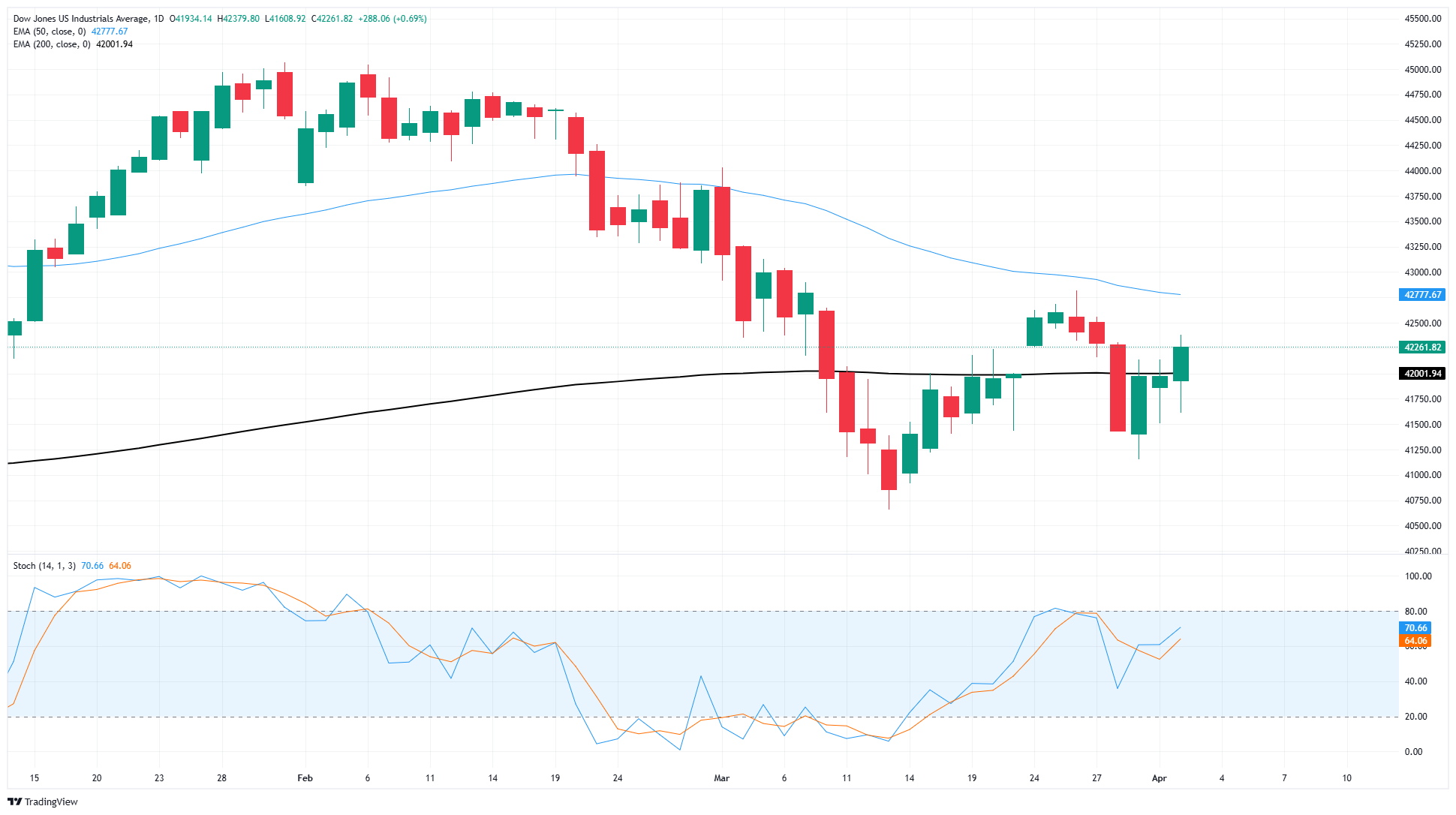- The Dow Jones rose on Tuesday, climbing 350 points as markets barrel toward tariff deadline.
- The Trump administration is slated to outline its long-threatened package of tariffs.
- Tariff package announcement is set for 1900 GMT (4 pm EST).
The Dow Jones Industrial Average (DJIA) took a step higher in early Tuesday trading, climbing 350 points and adding 0.85% from the day’s opening bids as investors lean into bets that the Trump administration’s long-awaited “reciprocal” tariffs package will be nowhere near as devastating as US President Donald Trump has been threatening. Donald Trump campaigned on promises of using widespread tariffs against all of the US’s trading partners to force better deals out of the rest of the free world.
April 2: Tariff Day
The Trump administration has been in the White House for 72 days, and is still grappling with how to execute Donald Trump’s “day one” tariffs after several delays. Despite an uptick in volatility and souring risk sentiment in the face of President Trump attempting to kick off a global trade war, markets are overall betting that tariffs will either be delayed for a fifth straight time, or will be nowhere near as high as President Trump has been threatening.
ADP Employment Change numbers for March came in much stronger than expected, rising 155K new payroll positions compared to February’s revised print of 84K. The upswing flouts rising fears of a weakening labor market. However, the key labor figure will be Friday’s upcoming Nonfarm Payrolls (NFP). Although the ADP payroll figures have long been held as a “preview” of NFP net job gains, the correlation between the two figures has been broken for years.
Stock news
Equity markets are broadly higher as investors barrel toward the Trump administration’s self-styled “Liberation Day”. The Dow Jones added nearly a full percent from Wednesday’s opening bids, while the Standard & Poor’s 500 megacap equity index also rallied 52 points to add 0.85%. The Nasdaq Composite tech-heavy index surged 1.3%, climbing 230 points.
Read more stock news: Tesla stock rallies despite Q1 delivery ‘disaster’
Dow Jones price forecast
Wednesday saw a bullish spark from the Dow Jones Industrial Average, with bids pushing back above the 200-day Exponential Moving Average (EMA) near the 42,000 handle. Macro flows are dominating the major equity index on Wednesday, crimping technical readings.
An extended upshot will see the Dow Jones climb back over the 50-day EMA near 42,775. On the low side, a fresh plunge below the 200-day EMA will set up price action for a fresh slide to March’s swing low below 40,800.
Dow Jones daily chart
Dow Jones FAQs
The Dow Jones Industrial Average, one of the oldest stock market indices in the world, is compiled of the 30 most traded stocks in the US. The index is price-weighted rather than weighted by capitalization. It is calculated by summing the prices of the constituent stocks and dividing them by a factor, currently 0.152. The index was founded by Charles Dow, who also founded the Wall Street Journal. In later years it has been criticized for not being broadly representative enough because it only tracks 30 conglomerates, unlike broader indices such as the S&P 500.
Many different factors drive the Dow Jones Industrial Average (DJIA). The aggregate performance of the component companies revealed in quarterly company earnings reports is the main one. US and global macroeconomic data also contributes as it impacts on investor sentiment. The level of interest rates, set by the Federal Reserve (Fed), also influences the DJIA as it affects the cost of credit, on which many corporations are heavily reliant. Therefore, inflation can be a major driver as well as other metrics which impact the Fed decisions.
Dow Theory is a method for identifying the primary trend of the stock market developed by Charles Dow. A key step is to compare the direction of the Dow Jones Industrial Average (DJIA) and the Dow Jones Transportation Average (DJTA) and only follow trends where both are moving in the same direction. Volume is a confirmatory criteria. The theory uses elements of peak and trough analysis. Dow’s theory posits three trend phases: accumulation, when smart money starts buying or selling; public participation, when the wider public joins in; and distribution, when the smart money exits.
There are a number of ways to trade the DJIA. One is to use ETFs which allow investors to trade the DJIA as a single security, rather than having to buy shares in all 30 constituent companies. A leading example is the SPDR Dow Jones Industrial Average ETF (DIA). DJIA futures contracts enable traders to speculate on the future value of the index and Options provide the right, but not the obligation, to buy or sell the index at a predetermined price in the future. Mutual funds enable investors to buy a share of a diversified portfolio of DJIA stocks thus providing exposure to the overall index.


